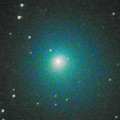
|
Now it is very bright as 7.5 mag (Mar. 15, Piotr Guzik). It approaches to the earth down to 0.14 a.u. from March to April, and brightens up to 5-6 mag. It may brighten furthermore in outburst. It is observable in excellent condition in the Northern Hemisphere. In the Southern Hemisphere, it will not be observable for about one month from late March to late April.
Date(TT) R.A. (2000) Decl. Delta r Elong. m1 Best Time(A, h)
Mar. 18 10 36.90 49 15.7 0.158 1.102 129 6.8 22:56 (180, 75)
Mar. 25 11 38.20 58 42.7 0.146 1.076 119 6.1 23:33 (180, 66)
|
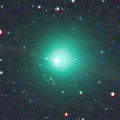
|
It brightened up to 7.9 mag in mid February (Feb. 21, Osamu Miyazaki). It is appearing in the morning sky in the Southern Hemisphere. It stays observable after this while the comet will be fading. In the Northern Hemisphere, it stays unobservable until May when it becomes fainter than 14 mag.
Date(TT) R.A. (2000) Decl. Delta r Elong. m1 Best Time(A, h)
Mar. 18 22 54.94 -12 51.1 0.696 0.397 18 6.7 4:42 (276,-14)
Mar. 25 22 36.52 -16 46.4 0.802 0.512 30 7.8 4:32 (284, -9)
|

|
Now it is 10.0 mag (Mar. 6, Chris Wyatt). It is expected to brighten up to 7 mag from April to May. But recently it is fainter than predicted. It locates somewhat low at the high light.
Date(TT) R.A. (2000) Decl. Delta r Elong. m1 Best Time(A, h)
Mar. 18 19 20.79 -20 57.9 1.355 1.357 68 8.5 4:42 (316, 20)
Mar. 25 19 54.71 -19 0.8 1.287 1.289 67 8.1 4:32 (312, 19)
|
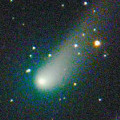
|
Now it is 9.8 mag (Mar. 9, Katsumi Yoshimoto). It is expected to brighten up to 6-7 mag from April to July. In the Northern Hemisphere, it stays observable in excellent condition until June. In the Southern Hemisphere, it stays extremely low for a while.
Date(TT) R.A. (2000) Decl. Delta r Elong. m1 Best Time(A, h)
Mar. 18 16 30.29 47 6.9 1.502 1.995 104 8.9 4:42 (185, 78)
Mar. 25 16 32.12 47 25.8 1.420 1.945 105 8.7 4:22 (180, 78)
|

|
Bright new comet. Now it is bright as 11.8 mag (Mar. 10, Hidetaka Sato). In the Northern Hemisphere, it stays observable until late April while the comet will be brightening gradually. In the Southern Hemisphere, it becomes unobservable in early April.
Date(TT) R.A. (2000) Decl. Delta r Elong. m1 Best Time(A, h)
Mar. 18 19 39.69 -22 45.1 0.761 0.957 64 11.7 4:42 (314, 16)
Mar. 25 20 32.66 -8 38.1 0.641 0.837 56 10.8 4:32 (297, 20)
|

|
Now it is 12.2 mag (Mar. 6, Chris Wyatt). Bright new fragment BT was discovered on Feb. 10. Now the fragment BT is fainter than the primary component. In the Southern Hemisphere, it stays observable for a long time after this. In the Northern Hemisphere, it is not observable temporarily until mid June.
Date(TT) R.A. (2000) Decl. Delta r Elong. m1 Best Time(A, h)
Mar. 18 21 11.13 -19 5.3 1.426 0.972 42 12.0 4:42 (296, 3)
Mar. 25 21 44.37 -17 35.8 1.458 0.979 41 12.1 4:32 (293, 1)
|

|
It has not been observed yet in this apparition. The condition of this apparition is worst. It will brighten up to 10 mag in spring, but not observable at all.
Date(TT) R.A. (2000) Decl. Delta r Elong. m1 Best Time(A, h)
Mar. 18 23 58.43 4 27.1 2.147 1.161 5 12.6 19:33 (105,-13)
Mar. 25 0 25.21 6 26.9 2.116 1.127 5 12.2 19:40 (108,-13)
|
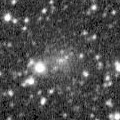
|
Bright new comet. Now it is 12.2 mag (Mar. 3, Seiichi Yoshida). It stays 13 mag until May. In the Southern Hemisphere, it stays observable for a long time, but it stays low. It will not be observable in early April in the Northern Hemisphere.
Date(TT) R.A. (2000) Decl. Delta r Elong. m1 Best Time(A, h)
Mar. 18 20 38.85 -8 26.9 1.322 0.993 48 13.1 4:42 (293, 16)
Mar. 25 21 17.80 -7 7.2 1.332 0.948 45 12.9 4:32 (288, 13)
|
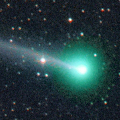
|
It approached to the earth down to 0.08 a.u. in mid February, and brightened up to 6.5 mag (Feb. 10, Danil Sidorko). Now it is fading rapidly. It has already faded down to 10.8 mag (Mar. 7, Osamu Miyazaki).
Date(TT) R.A. (2000) Decl. Delta r Elong. m1 Best Time(A, h)
Mar. 18 10 37.33 21 53.7 0.504 1.461 152 13.0 22:52 ( 0, 77)
Mar. 25 10 33.09 20 33.4 0.620 1.552 146 13.8 22:21 ( 0, 75)
|
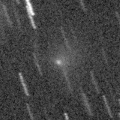
|
It brightened very rapidly. Now it is bright as 13.2 mag (Mar. 15, Piotr Guzik). Small comet, but it approaches to the sun down to 0.9 a.u., and to the earth down to 0.5 a.u. It is observable in excellent condition in the Northern Hemisphere. In the Southern Hemisphere, it stays observable only until mid February.
Date(TT) R.A. (2000) Decl. Delta r Elong. m1 Best Time(A, h)
Mar. 18 3 4.53 52 4.5 0.554 0.930 66 13.0 19:33 (132, 43)
Mar. 25 3 35.59 61 44.3 0.536 0.963 70 13.8 19:40 (146, 43)
|
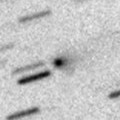
|
Now it is 16.4 mag (Mar. 8, Thomas Lehmann). It is expected to brighten up to 10 mag in summer. But actually, it is much fainter than this ephemeris recently. It will be observable in excellent condition in the Southern Hemisphere. It locates low in the Northern Hemisphere.
Date(TT) R.A. (2000) Decl. Delta r Elong. m1 Best Time(A, h)
Mar. 18 16 2.07 -13 48.5 1.195 1.860 115 13.6 4:20 ( 0, 41)
Mar. 25 16 11.10 -14 35.5 1.107 1.828 120 13.3 4:02 ( 0, 40)
|

|
Appearing in the morning sky. Now it is 15.3 mag (Mar. 5, CAO, San Pedro de Atacama).
Date(TT) R.A. (2000) Decl. Delta r Elong. m1 Best Time(A, h)
Mar. 18 21 10.76 -16 52.5 6.555 5.858 42 13.8 4:42 (294, 5)
Mar. 25 21 15.45 -16 27.5 6.476 5.856 48 13.8 4:32 (296, 7)
|

|
Small outburst occured in mid March. Now it is 13.5 mag (Mar. 15, J.P.Navarro Pina). It is observable in excellent condition in the Northern Hemisphere. It stays low in the Southern Hemisphere.
Date(TT) R.A. (2000) Decl. Delta r Elong. m1 Best Time(A, h)
Mar. 18 11 45.66 32 25.4 1.646 2.548 148 14.4 0:05 ( 0, 87)
Mar. 25 11 40.82 32 11.3 1.684 2.566 145 14.6 23:28 ( 0, 87)
|

|
Now it is bright as 14.4 mag (Jan. 14, Thomas Lehmann). It will be observable at 11 mag for a long time from 2017 to 2018. It will be unobservable temporarily soon in the Northern Hemisphere, or in May in the Southern Hemisphere.
Date(TT) R.A. (2000) Decl. Delta r Elong. m1 Best Time(A, h)
Mar. 18 3 3.89 -22 4.4 5.434 4.878 51 14.6 19:33 ( 57, 7)
Mar. 25 3 8.32 -20 45.3 5.438 4.825 47 14.5 19:40 ( 62, 3)
|
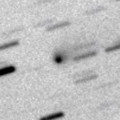
|
Now it is 15.4 mag (Feb. 25, T. Ikemura, H. Sato). It will brighten up to 14 mag from spring to summer. It locates somewhat low in the Northern Hemisphere. The perihelion distance increased from 2.4 a.u. to 2.9 a.u. in this apparition. So it will not be bright as before.
Date(TT) R.A. (2000) Decl. Delta r Elong. m1 Best Time(A, h)
Mar. 18 16 26.84 -19 29.1 2.620 3.094 109 14.8 4:42 (359, 35)
Mar. 25 16 29.44 -19 46.1 2.518 3.082 115 14.7 4:20 ( 0, 35)
|
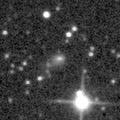
|
Now it is 15.7 mag (Mar. 7, Kunihiro Shima). It will be observable at 13 mag for a long time from 2017 to 2018.
Date(TT) R.A. (2000) Decl. Delta r Elong. m1 Best Time(A, h)
Mar. 18 19 11.82 3 3.2 5.003 4.750 69 15.1 4:42 (300, 40)
Mar. 25 19 11.53 4 15.6 4.855 4.714 75 15.0 4:32 (303, 44)
|

|
Now it is 15.6 mag (Feb. 15, Alexander Baransky). It will brighten up to 12-13 mag and will be observable in good condition in summer. Now it is not observable. It will appear in the morning sky in May.
Date(TT) R.A. (2000) Decl. Delta r Elong. m1 Best Time(A, h)
Mar. 18 0 13.11 13 22.7 4.147 3.199 15 15.1 19:33 (110, -5)
Mar. 25 0 14.74 13 29.8 4.132 3.162 11 15.1 4:32 (245,-10)
|

|
Now it is 15.6 mag (Mar. 6, Kunihiro Shima). Now it is not observable. But it will appear in the morning sky in June in the Southern Hemisphere, or in July in the Northern Hemisphere. Then it stays observable at 15.5 mag unil the end of 2017.
Date(TT) R.A. (2000) Decl. Delta r Elong. m1 Best Time(A, h)
Mar. 18 1 37.44 0 8.2 6.196 5.327 26 15.2 19:33 ( 87, 4)
Mar. 25 1 43.68 0 37.9 6.258 5.347 21 15.3 19:40 ( 92, -1)
|

|
Now it is 15.0 mag (Feb. 25, Alexander Baransky). It stays 15 mag until spring. But it is already unobservable in the Southern Hemisphere. It will be getting lower gradually after this also in the Northern Hemisphere.
Date(TT) R.A. (2000) Decl. Delta r Elong. m1 Best Time(A, h)
Mar. 18 2 17.73 23 20.3 2.290 1.709 43 15.3 19:33 (102, 25)
Mar. 25 2 38.34 24 50.8 2.333 1.717 41 15.4 19:40 (105, 23)
|

|
Now it is 15.3 mag (Dec. 29, Kunihiro Shima). Now it is not observable. In the Northern Hemisphere, it will appear in the morning sky in late April. Then it will brighten up to 14 mag from summer to next winter, and it will be observable in excellent condition. In the Southern Hemisphere, it will be observable in the very low sky only from May to June.
Date(TT) R.A. (2000) Decl. Delta r Elong. m1 Best Time(A, h)
Mar. 18 23 35.80 9 49.7 4.610 3.640 11 15.4 4:42 (251, -9)
Mar. 25 23 41.04 11 27.9 4.574 3.609 13 15.4 4:32 (252, -5)
|

|
It has not been observed yet in this apparition. It will brighten up to 12 mag in summer. It will be observable in excellent condition in the Southern Hemisphere. It locates somewhat low in the Northern Hemisphere.
Date(TT) R.A. (2000) Decl. Delta r Elong. m1 Best Time(A, h)
Mar. 18 18 12.91 -33 9.1 2.316 2.434 84 15.9 4:42 (336, 17)
Mar. 25 18 24.40 -33 15.9 2.206 2.407 89 15.7 4:32 (338, 18)
|

|
Now it is 15.7 mag (Feb. 23, T. Ikemura, H. Sato). It stays 16-17 mag for a long time from 2016 to 2019. It stays near by the equator.
Date(TT) R.A. (2000) Decl. Delta r Elong. m1 Best Time(A, h)
Mar. 18 9 6.07 4 42.6 8.835 9.607 138 15.9 21:21 ( 0, 60)
Mar. 25 9 5.38 5 1.8 8.908 9.603 131 15.9 20:53 ( 0, 60)
|

|
It brightened up to 11 mag from spring to summer in 2016. It is appearing in the morning sky again. Now it is 16.5 mag (Mar. 4, T. Ikemura, H. Sato). It will be observable at 16-17 mag in good condition from spring to summer.
Date(TT) R.A. (2000) Decl. Delta r Elong. m1 Best Time(A, h)
Mar. 18 19 49.19 -19 11.7 2.988 2.664 61 15.9 4:42 (310, 17)
Mar. 25 19 57.79 -18 48.4 2.942 2.705 66 15.9 4:32 (311, 19)
|

|
Now it is 16.3 mag (Feb. 25, Alexander Baransky). It stays observable at 16 mag until June. It locates low in the Southern Hemisphere.
Date(TT) R.A. (2000) Decl. Delta r Elong. m1 Best Time(A, h)
Mar. 18 6 46.23 27 36.8 3.347 3.698 102 16.0 19:33 ( 44, 80)
Mar. 25 6 49.16 27 31.5 3.442 3.692 96 16.0 19:40 ( 65, 75)
|

|
Now it is 17.3 mag (Mar. 3, T. Ikemura, H. Sato). It was observed at 16 mag from spring to summer in 2016. It will be observable at 16 mag also in 2017 from winter to spring.
Date(TT) R.A. (2000) Decl. Delta r Elong. m1 Best Time(A, h)
Mar. 18 18 11.76 1 46.7 3.297 3.354 84 16.1 4:42 (317, 48)
Mar. 25 18 16.60 3 42.2 3.229 3.374 89 16.1 4:32 (319, 52)
|

|
Now it is 17.0 mag (Mar. 2, Thomas Lehmann). It is expected to brighten up to 9 mag in summer in 2018. In the Northern Hemisphere, it stays observable until 2018 summer while the comet will be brightening. In the Southern Hemisphere, it is hardly observable in 2017, but it will be observable in good condition in 2018.
Date(TT) R.A. (2000) Decl. Delta r Elong. m1 Best Time(A, h)
Mar. 18 19 8.85 47 30.0 5.762 5.634 77 16.3 4:42 (235, 57)
Mar. 25 19 10.89 48 8.6 5.672 5.578 79 16.2 4:32 (233, 60)
|

|
It stayed bright 12 mag for a long time from autum in 2015 to summer in 2016. Now it is fading. It has already faded dwon to 16.4 mag (Feb. 15, T. Ikemura, H. Sato).
Date(TT) R.A. (2000) Decl. Delta r Elong. m1 Best Time(A, h)
Mar. 18 17 24.30 -7 39.2 4.336 4.554 96 16.4 4:42 (339, 45)
Mar. 25 17 22.85 -8 1.5 4.271 4.605 103 16.4 4:32 (345, 46)
|
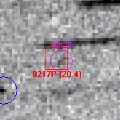
|
It will brighten rapidly, and it is expected to brighten up to 12 mag from July to September. In the Southern Hemisphere, it stays at the same altitude in the morning sky. In the Northern Hemisphere, it will be getting higher slowly.
Date(TT) R.A. (2000) Decl. Delta r Elong. m1 Best Time(A, h)
Mar. 18 20 57.30 -14 36.5 2.472 1.900 44 16.8 4:42 (295, 9)
Mar. 25 21 15.64 -13 44.0 2.369 1.843 47 16.5 4:32 (294, 9)
|

|
Now it is 16.0 mag (Feb. 16, Alexander Baransky). It stays 16 mag for a long time from 2017 to 2018.
Date(TT) R.A. (2000) Decl. Delta r Elong. m1 Best Time(A, h)
Mar. 18 8 29.97 1 54.2 4.952 5.643 129 16.5 20:45 ( 0, 57)
Mar. 25 8 25.93 3 10.9 5.029 5.626 122 16.5 20:14 ( 0, 58)
|
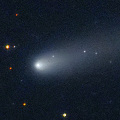
|
It brightened up to 11-12 mag from summer to autumn in last year. Now it is fading. It has already faded down to 14.9 mag (Mar. 3, T. Ikemura, H. Sato).
Date(TT) R.A. (2000) Decl. Delta r Elong. m1 Best Time(A, h)
Mar. 18 11 58.61 -25 38.0 1.565 2.495 153 16.5 0:18 ( 0, 29)
Mar. 25 11 51.72 -24 30.1 1.596 2.542 156 16.7 23:39 ( 0, 31)
|

|
Now it is 16.2 mag (Mar. 4, T. Ikemura, H. Sato). It stays 16.5 mag from 2016 to 2017. In the Northern Hemisphere, it stays observable in good condition for a long time. In the Southern Hemisphere, it will never be observable again.
Date(TT) R.A. (2000) Decl. Delta r Elong. m1 Best Time(A, h)
Mar. 18 18 51.24 47 39.3 6.366 6.280 80 16.6 4:42 (234, 60)
Mar. 25 18 54.97 49 8.1 6.341 6.285 82 16.6 4:32 (230, 62)
|
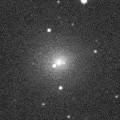
|
It brightened up to 11-12 mag in autumn. Now it is fading. It has already faded down to 16.9 mag (Mar. 3, T. Ikemura, H. Sato).
Date(TT) R.A. (2000) Decl. Delta r Elong. m1 Best Time(A, h)
Mar. 18 13 44.12 -15 54.1 1.592 2.487 147 16.9 2:03 ( 0, 39)
Mar. 25 13 38.21 -15 18.2 1.595 2.537 155 17.1 1:30 ( 0, 40)
|

|
It brightened up to 6 mag from autumn in 2015 to early 2016. Now it is fading. It has already faded down to 17.1 mag (Feb. 28, Yasukazu Ikari). It is observable in good condition in the Northern Hemisphere. It is not observable after this in the Southern Hemisphere.
Date(TT) R.A. (2000) Decl. Delta r Elong. m1 Best Time(A, h)
Mar. 18 3 2.66 43 53.3 6.510 6.107 62 16.9 19:33 (121, 41)
Mar. 25 3 5.76 43 37.3 6.668 6.171 56 17.0 19:40 (122, 36)
|

|
It has not been observed since last April. Now it is fading. But it must be bright as 17 mag still now.
Date(TT) R.A. (2000) Decl. Delta r Elong. m1 Best Time(A, h)
Mar. 18 17 8.79 -19 36.0 2.685 3.012 99 16.9 4:42 (347, 34)
Mar. 25 17 10.26 -19 14.2 2.655 3.083 106 17.0 4:32 (352, 35)
|
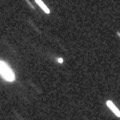
|
Now it is 16.5 mag (Feb. 23, T. Ikemura, H. Sato). It brightened rapidly, and became brighter than originally expected. It stays 17 mag until 2017. In the Northern Hemisphere, it stays observable in excellent condition for a long time. It is not observable in the Southern Hemisphere.
Date(TT) R.A. (2000) Decl. Delta r Elong. m1 Best Time(A, h)
Mar. 18 12 37.59 61 31.0 6.879 7.411 118 17.0 0:57 (180, 64)
Mar. 25 12 27.10 61 26.0 6.916 7.420 116 17.0 0:19 (180, 64)
|

|
Now it is 17.0 mag (Mar. 2, Kunihiro Shima). It is observable in excellent condition in the Northern Hemisphere. It locates low in the Southern Hemisphere.
Date(TT) R.A. (2000) Decl. Delta r Elong. m1 Best Time(A, h)
Mar. 18 6 49.93 32 11.6 3.156 3.518 103 17.0 19:33 ( 65, 84)
Mar. 25 6 54.38 31 45.5 3.263 3.531 97 17.1 19:40 ( 78, 78)
|

|
It brightened up to 15 mag in early 2016. Now it is fading. It has already faded down to 17.1 mag (Mar. 3, K. Hills). In the Northern Hemisphere, it stays observable in good condition for a long time until autumn when the comet will be fainter than 18 mag. It will never be observable after this in the Southern Hemisphere.
Date(TT) R.A. (2000) Decl. Delta r Elong. m1 Best Time(A, h)
Mar. 18 15 18.75 71 45.2 6.208 6.491 102 17.1 3:36 (180, 53)
Mar. 25 15 10.30 72 2.9 6.253 6.521 101 17.1 3:01 (180, 53)
|

|
Now it is 17.3 mag (Mar. 6, iTelescope Observatory, Siding Spring). It will brighten up to 15.5 mag in summer. It will be observable in excellent condition in the Southern Hemisphere. It locates somewhat low in the Northern Hemisphere.
Date(TT) R.A. (2000) Decl. Delta r Elong. m1 Best Time(A, h)
Mar. 18 19 56.96 -47 5.3 3.005 2.793 68 17.4 4:42 (327, -5)
Mar. 25 20 12.66 -46 35.1 2.906 2.760 71 17.2 4:32 (327, -4)
|
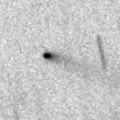
|
Now it is 17.0 mag (Feb. 16, Alexander Baransky). It was observed at 17 mag last winter. It will be observable at 17 mag again next winter. It is observable in good condition in the Northern Hemisphere. But it locates low in the Southern Hemisphere.
Date(TT) R.A. (2000) Decl. Delta r Elong. m1 Best Time(A, h)
Mar. 18 11 5.17 40 18.6 3.408 4.214 139 17.4 23:20 (180, 85)
Mar. 25 11 1.76 41 11.8 3.491 4.244 133 17.5 22:49 (180, 84)
|
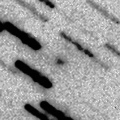
|
Now it is 17.8 mag (Feb. 28, T. Ikemura, H. Sato). In the Northern Hemisphere, it is observable at 17-18 mag until March. It is not observable in the Southern Hemisphere.
Date(TT) R.A. (2000) Decl. Delta r Elong. m1 Best Time(A, h)
Mar. 18 12 12.74 82 44.5 1.753 2.136 98 17.5 0:40 (180, 42)
Mar. 25 10 23.19 78 37.6 1.794 2.175 98 17.6 22:07 (180, 47)
|

|
Now it is 17.1 mag (Mar. 7, iTelescope Observatory, Siding Spring). It is observable at 17.5 mag in good condition in spring. It locates somewhat low in the Northern Hemisphere.
Date(TT) R.A. (2000) Decl. Delta r Elong. m1 Best Time(A, h)
Mar. 18 13 2.57 -32 19.8 4.149 4.975 142 17.6 1:22 ( 0, 23)
Mar. 25 12 54.29 -30 57.3 4.089 4.973 149 17.5 0:46 ( 0, 24)
|

|
Now it is 17.9 mag (Mar. 3, T. Ikemura, H. Sato). It stays observable in good condition for a while, but it will be fainter than 18 mag in April.
Date(TT) R.A. (2000) Decl. Delta r Elong. m1 Best Time(A, h)
Mar. 18 12 33.33 3 51.3 1.829 2.812 168 17.6 0:52 ( 0, 59)
Mar. 25 12 28.02 4 43.6 1.850 2.842 172 17.7 0:20 ( 0, 60)
|
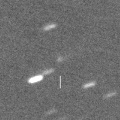
|
Now it is 17.8 mag (Feb. 3, T. Ikemura, H. Sato). It is observable at 17.5 mag in good condition from winter to spring.
Date(TT) R.A. (2000) Decl. Delta r Elong. m1 Best Time(A, h)
Mar. 18 15 11.13 -11 42.0 1.681 2.429 128 17.6 3:29 ( 0, 43)
Mar. 25 15 10.59 -11 41.9 1.634 2.447 135 17.7 3:01 ( 0, 43)
|

|
Now it is 17.0 mag (Mar. 13, E. Primucci). In the Southern Hemisphere, it is observable at 17.5 mag in good condition in spring. It is hardly observable in the Northern Hemisphere.
Date(TT) R.A. (2000) Decl. Delta r Elong. m1 Best Time(A, h)
Mar. 18 13 5.60 -46 35.7 5.174 5.858 129 17.7 1:25 ( 0, 8)
Mar. 25 13 2.14 -45 58.0 5.127 5.871 134 17.7 0:54 ( 0, 9)
|
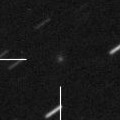
|
Now it is 18.0 mag (Feb. 28, Yasukazu Ikari). It is observable in good condition in the Southern Hemisphere.
Date(TT) R.A. (2000) Decl. Delta r Elong. m1 Best Time(A, h)
Mar. 18 5 45.50 -25 12.9 3.770 3.874 88 17.8 19:33 ( 23, 26)
Mar. 25 5 46.18 -22 37.0 3.858 3.880 83 17.8 19:40 ( 32, 25)
|

|
Very far object. Outburst occured on Feb. 20, 2015, and it brightened up to 15 mag. Now it is 17.8 mag (June 4, Space Surveillance Telescope, Atom Site). It is observable in excellent condition in the Southern Hemisphere. It locates low in the Northern Hemisphere.
Date(TT) R.A. (2000) Decl. Delta r Elong. m1 Best Time(A, h)
Mar. 18 14 42.35 -26 40.8 8.696 9.368 130 17.9 3:01 ( 0, 28)
Mar. 25 14 41.22 -26 35.8 8.619 9.374 137 17.9 2:32 ( 0, 28)
|
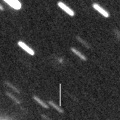
|
It stays at 14 mag for a long time from 2018 to 2019. In the Northern Hemisphere, it stays observable in good condition while the comet will be brightening gradually. In the Southern Hemisphere, it is not observable until 2018 October.
Date(TT) R.A. (2000) Decl. Delta r Elong. m1 Best Time(A, h)
Mar. 18 18 32.89 42 28.1 5.436 5.404 82 18.0 4:42 (244, 64)
Mar. 25 18 33.06 44 7.4 5.333 5.352 85 17.9 4:32 (238, 67)
|
|
![]()
 73P/Schwassmann-Wachmann 3
73P/Schwassmann-Wachmann 3 103P/Hartley 2
103P/Hartley 2 C/2017 E1 ( Borisov )
C/2017 E1 ( Borisov ) 45P/Honda-Mrkos-Pajdusakova
45P/Honda-Mrkos-Pajdusakova C/2016 VZ18 ( PanSTARRS )
C/2016 VZ18 ( PanSTARRS ) 71P/Clark
71P/Clark 29P/Schwassmann-Wachmann 1
29P/Schwassmann-Wachmann 1 315P/2013 V6 ( LONEOS )
315P/2013 V6 ( LONEOS ) C/2016 R2 ( PanSTARRS )
C/2016 R2 ( PanSTARRS ) 65P/Gunn
65P/Gunn C/2015 O1 ( PanSTARRS )
C/2015 O1 ( PanSTARRS ) C/2015 VL62 ( Lemmon-Yeung-PanSTARRS )
C/2015 VL62 ( Lemmon-Yeung-PanSTARRS ) C/2011 KP36 ( Spacewatch )
C/2011 KP36 ( Spacewatch ) 93P/Lovas 1
93P/Lovas 1 C/2016 N4 ( MASTER )
C/2016 N4 ( MASTER ) 213P/Van Ness
213P/Van Ness C/2014 B1 ( Schwartz )
C/2014 B1 ( Schwartz ) 81P/Wild 2
81P/Wild 2 74P/Smirnova-Chernykh
74P/Smirnova-Chernykh C/2016 B1 ( NEOWISE )
C/2016 B1 ( NEOWISE ) C/2016 M1 ( PanSTARRS )
C/2016 M1 ( PanSTARRS ) C/2014 W2 ( PanSTARRS )
C/2014 W2 ( PanSTARRS ) 217P/LINEAR
217P/LINEAR C/2016 A1 ( PanSTARRS )
C/2016 A1 ( PanSTARRS ) 43P/Wolf-Harrington
43P/Wolf-Harrington C/2014 OE4 ( PanSTARRS )
C/2014 OE4 ( PanSTARRS ) 144P/Kushida
144P/Kushida C/2013 US10 ( Catalina )
C/2013 US10 ( Catalina ) C/2015 TQ209 ( LINEAR )
C/2015 TQ209 ( LINEAR ) C/2014 R3 ( PanSTARRS )
C/2014 R3 ( PanSTARRS ) P/2015 TP200 ( LINEAR )
P/2015 TP200 ( LINEAR ) C/2013 V4 ( Catalina )
C/2013 V4 ( Catalina ) C/2017 D2 ( Barros )
C/2017 D2 ( Barros ) C/2015 X7 ( ATLAS )
C/2015 X7 ( ATLAS ) C/2016 T2 ( Matheny )
C/2016 T2 ( Matheny ) C/2017 D3 ( ATLAS )
C/2017 D3 ( ATLAS ) 118P/Shoemaker-Levy 4
118P/Shoemaker-Levy 4 94P/Russell 4
94P/Russell 4 C/2017 E3 ( PanSTARRS )
C/2017 E3 ( PanSTARRS ) C/2017 A3 ( Elenin )
C/2017 A3 ( Elenin ) C/2013 C2 ( Tenagra )
C/2013 C2 ( Tenagra ) C/2016 N6 ( PanSTARRS )
C/2016 N6 ( PanSTARRS )![]()








































